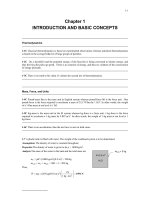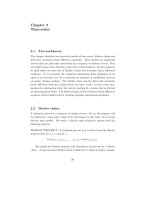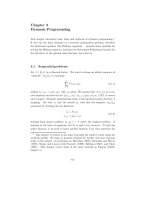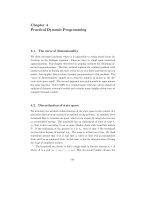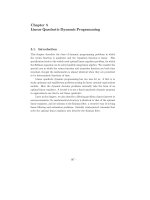Insect Ecology - An Ecosystem Approach 2nd ed - Chapter 2 pdf
Bạn đang xem bản rút gọn của tài liệu. Xem và tải ngay bản đầy đủ của tài liệu tại đây (3.18 MB, 38 trang )
THE INDIVIDUAL ORGANISM IS A FUNDAMENTAL
unit of ecology. Organisms interact with their
environment and affect ecosystem processes largely
through their cumulative physiological and behavioral
responses to environmental variation. Individual success
in finding and using necessary habitats and resources to
gain reproductive advantage determines fitness. Insects
have a number of general attributes that have contributed to their ecological
success (Romoser and Stoffolano 1998).
First, small size (an attribute shared with other invertebrates and
microorganisms) has permitted exploitation of habitat and food resources at a
microscopic scale. Insects can take shelter from adverse conditions in microsites
too small for larger organisms (e.g., within individual leaves). Large numbers of
insects can exploit the resources represented by a single leaf, often by partitioning
leaf resources. Some species feed on cell contents, others on sap in leaf veins, some
on top of the leaf, others on the underside, and some internally. At the same time,
small size makes insects sensitive to changes in temperature, moisture, air or water
chemistry, and other factors.
Second, the exoskeleton (shared with other arthropods) provides protection
against predation and desiccation or water-logging (necessary for small organisms)
and innumerable points of muscle attachment (for flexibility). However, the
exoskeleton also limits the size attainable by arthropods. The increased weight of
exoskeleton required to support larger body size would limit mobility. Larger
arthropods occurred prehistorically, before the appearance of faster, more flexible
I
SECTION
ECOLOGY
OF
INDIVIDUAL
INSECTS
002-P088772.qxd 1/24/06 10:33 AM Page 15
vertebrate predators. Larger arthropods also occur in aquatic environments, where
water helps support their weight.
Third, metamorphosis is necessary for (exoskeleton-limited) growth but permits
partitioning of habitats and resources among life stages. Immature and adult insects
can differ dramatically in form and function and thereby live in different habitats
and feed on different resources, reducing intraspecific competition. For example,
dragonflies and mayflies live in aquatic ecosystems during immature stages but in
terrestrial ecosystems as adults. Many Lepidoptera feed on foliage as immatures and
on nectar as adults. Among holometabolous insects, the quiescent, pupal stage
facilitates survival during unfavorable environmental conditions. However, insects,
as well as other arthropods, are particularly vulnerable to desiccation and predation
during ecdysis (molting).
Finally, flight evolved first among insects and conferred a distinct advantage over
other organisms. Flight permits rapid long-distance movement that facilitates
discovery of new resources, as well as escape from predators or unfavorable
conditions. Flight remains a dominant feature of insect ecology.
This section focuses on aspects of physiology and behavior that affect insect
interactions with environmental conditions, specifically adaptations that favor
survival and reproduction in variable environments and mechanisms for finding,
exploiting, and allocating resources. Physiology and behavior are closely
integrated. For example, movement, including dispersal, is affected by
physiological perception of chemical gradients, fat storage, rapid oxygen supply,
etc. Similarly, physiological processes are affected by insect selection of thermally
suitable location, choice of food resources, etc. Chemical defenses against
predators are based on physiological processes but often are enhanced by
behaviors that facilitate expression of chemical defenses (e.g., thrashing or
regurgitation). Organisms affect ecosystem processes, such as energy and nutrient
fluxes, through their spatial and temporal patterns of energy and nutrient
acquisition and allocation.
Chapter 2 deals with physiological and behavioral responses to changing
environmental conditions. Chapter 3 addresses physiological and behavioral
mechanisms for finding and exploiting resources. Chapter 4 describes allocation of
resources to various metabolic pathways and behaviors that facilitate resource
acquisition, mate selection, reproduction, interaction with other organisms, etc.
Physiology and behavior interact to determine the conditions under which insects
can survive and the means by which they acquire and use available resources.
These ecological attributes affect population ecology (such as population structure,
responses to environmental change and disturbances, biogeography, etc., Section
II), community attributes (such as use of, or use by, other organisms as resources,
Section III), and ecosystem attributes (such as rates and directions of energy and
matter flows, Section IV).
002-P088772.qxd 1/24/06 10:33 AM Page 16
2
Responses to Abiotic
Conditions
I. The Physical Template
A. Biomes
B. Environmental Variation
C. Disturbances
II. Surviving Variable Abiotic Conditions
A. Thermoregulation
B. Water Balance
C. Air and Water Chemistry
D. Other Abiotic Factors
III. Factors Affecting Dispersal Behavior
A. Life History Strategy
B. Crowding
C. Nutritional Status
D. Habitat and Resource Conditions
E. Mechanism of Dispersal
IV. Responses to Anthropogenic Changes
V. Summary
INSECTS ARE A DOMINANT GROUP OF ORGANISMS IN VIRTUALLY ALL
terrestrial, freshwater, and near-coastal marine habitats, including many of the
harshest ecosystems on the globe (e.g., deserts, hot springs, and tundra).
However, particular species have restricted ranges of occurrence dictated by
their tolerances to a variety of environmental factors.
One of the earliest (and still important) objectives of ecologists was explana-
tion of the spatial patterns of species distributions (e.g., Andrewartha and
Birch 1954, A. Wallace 1876). The geographic ranges of insect species generally
are determined by their tolerances, or the tolerances of their food resources
and predators, to variation in abiotic conditions. Insect morphological,
physiological, and behavioral adaptations reflect the characteristic physical con-
ditions of the habitats in which they occur. However, variation in physical
conditions requires some flexibility in physiological and behavioral traits. All
ecosystems experience climatic fluctuation and periodic disturbances that affect
the survival of organisms in the community. Furthermore,anthropogenic changes
in habitat conditions increase the range of conditions to which organisms must
respond.
17
002-P088772.qxd 1/24/06 10:33 AM Page 17
I. THE PHYSICAL TEMPLATE
A. Biomes
Global patterns of temperature and precipitation, reflecting the interaction
among latitude, global atmospheric and oceanic circulation patterns, and topog-
raphy, establish a regional template of physical conditions that support charac-
teristic communities, called “biomes” (Fig. 2.1) (Finch and Trewartha 1949).
Latitudinal gradients in temperature from Earth’s equator to its poles define the
tropical, subtropical, temperate, and arctic zones. Precipitation patterns overlay
these temperature gradients. Warm, humid air rises in the tropics, drawing air
from higher latitudes into this equatorial convergence zone. The rising air cools
and condenses moisture, resulting in a band of high precipitation and tropical
rainforests centered on the equator. The cooled, dried air flows away from the
equatorial zone and warms as it descends in the “horse latitudes,” centered
around 30 degrees N and S.These latitudes are dominated by arid grassland and
desert ecosystems because of high evaporation rates in warm, dry air. Airflow at
these latitudes diverges to the equatorial convergence zone and to similar con-
vergence zones at about 60 degrees N and S latitudes. Rising air at 60 degrees N
and S latitudes creates bands of relatively high precipitation and low temperature
that support boreal forests.These latitudinal gradients in climate restrict the dis-
tribution of organisms on the basis of their tolerance ranges for temperature and
moisture. No individual species is capable of tolerating the entire range of tropi-
cal to arctic temperatures or desert to mesic moisture conditions.
Mountain ranges interact with oceanic and atmospheric circulation patterns
to modify latitudinal patterns of temperature, and precipitation. Mountains force
airflow upward, causing cooling, condensation, and precipitation on the wind-
ward side (Fig. 2.2). Drier air descends on the leeward side where it gains mois-
ture through evaporation. This orographic effect leads to development of mesic
environments on the windward side and arid environments on the leeward side
of mountain ranges.Mountains are characterized by elevational gradients of tem-
perature, moisture, and atmospheric conditions (e.g., lower elevations tend to be
warmer and drier, whereas higher elevations are cooler and moister).
Concentrations of oxygen and other gases decline with elevation so that species
occurring at higher elevations must be capable of surviving at low gas concentra-
tions. The montane gradient is much shorter than the corresponding latitudinal
gradient, with the same temperature change occurring in a 1000-m difference in
elevation or an 880-km difference in latitude. Hence, the range of habitat condi-
tions that occur over a wide latitudinal gradient occurs on a smaller scale in mon-
tane areas.
The relatively distinct combinations of temperature and precipitation
(MacMahon 1981) determine the assemblage of species capable of surviving and
defining the characteristic community type (i.e., tundra, temperate deciduous
forest, temperate coniferous forest, tropical rainforest, tropical dry forest, grass-
land, savanna, chaparral, and desert; Fig. 2.3). Representative terrestrial biomes
and their seasonal patterns of temperature and precipitation are shown in Figs.
2.4 and 2.5.
18
2. RESPONSES TO ABIOTIC CONDITIONS
002-P088772.qxd 1/24/06 10:33 AM Page 18
I. THE PHYSICAL TEMPLATE 19
30°
60°
Ice and water
30°
60°
0°
Tundra
Boreal forest
Temperate forest
Temperate grassland
Mountain ran
g
es
Chaparral
Desert
Tropical savanna
Tropical dry forest
Tropical deciduous forest
Tropical rainforest
FIG. 2.1 Global distribution of the major terrestrial biomes. The distribution of
biomes is affected by latitude, global atmospheric and oceanic circulation patterns, and
major mountain ranges. Modified from Finch and Trewartha (1949) with permission
from McGraw-Hill and E. Odum (1971) with permission from Saunders College
Publishing.
Habitat conditions in terrestrial biomes are influenced further by topograp-
hic relief, substrate structure and chemistry, and exposure to wind. For example,
topographic relief creates gradients in solar exposure and soil drainage, as well as
in temperature and moisture, providing local habitats for unique communities.
Local differences in substrate structure and chemistry may limit the ability of
many species of plants and animals, characteristic of the surrounding biome, to
survive. Some soils (e.g., sandy loams) are more fertile or more conducive to
excavation than others; serpentine soils and basalt flows require special adapta-
tions for survival by plants and animals. Insects that live in windy areas, espe-
cially alpine tundra and oceanic islands, often are flightless as a result of selection
against individuals blown away in flight. The resulting isolation of populations
results in rapid speciation.
Aquatic biomes are formed by topographic depressions and gradients that
create zones of standing or flowing water.Aquatic biomes vary in size, depth,flow
rate, and marine influence (i.e., lakes, ponds, streams, rivers, estuaries, and tidal
marshes; Fig. 2.6). Lotic habitats often show considerable gradation in tempera-
ture and solute concentrations with depth. Because water has high specific heat,
water changes temperature slowly relative to air temperature. However, because
water is most dense at 4°C, changes in density as temperature changes result in
seasonal stratification of water temperature. Thermal stratification develops in
the summer, as the surface of standing bodies of water warms and traps cooler,
denser water below the thermocline (the zone of rapid temperature change), and
002-P088772.qxd 1/24/06 10:33 AM Page 19
20 2. RESPONSES TO ABIOTIC CONDITIONS
FIG. 2.2 Orographic effect of mountain ranges. Interruption of airflow and
condensation of precipitation on the windward side (right) and clear sky on the leeward
side (left) of Mt. Hood, Cascade Mountains, Oregon, United States. Please see extended
permission list pg 569.
Arctic 8 alpine tundra
Coniferous forest
Deciduous forest
Desert
Grassland
Tropical forest
30
20
10
0
–10
Mean annual temperature (°C)
100 200 300 400
Mean annual precipitation (cm)
FIG. 2.3 Discrimination of geographic ranges of major terrestrial biomes on the
basis of temperature and precipitation. From MacMahon (1981) with permission from
Springer-Verlag. Please see extended permission list pg 569.
002-P088772.qxd 1/24/06 10:33 AM Page 20
I. THE PHYSICAL TEMPLATE 21
A
B
FIG. 2.4 Examples of ecosystem structure in representative terrestrial biomes. A: tundra
(alpine) (western United States), B: desert shrubland (southwestern United States), C: grassland
(central United States), D: tropical savanna (note termite mounds in foreground; northern
Australia), E: boreal forest (northwestern United States), F: temperate deciduous forest
(southeastern United States), and G: tropical rainforest (northern Panamá).
C
D
again in the winter, as freezing water rises to the surface, trapping warmer and
denser water below the ice. During fall and spring, changing surface temperatures
result in mixing of water layers and movement of oxygen and nutrients through-
out the water column. Hence, deeper zones in aquatic habitats show relatively
little variation in temperature, allowing aquatic insects to continue development
and activity throughout the year, even in temperate regions.
Habitat conditions in aquatic biomes are influenced further by substrate struc-
ture and chemistry; amount and chemistry of regional precipitation; and the char-
acteristics of surrounding terrestrial communities, including conditions upstream.
Substrate structure and chemistry determine flow characteristics (including tur-
bulence), pH, and inputs of nutrients from sedimentary sources. Amount and
chemistry of regional precipitation determine regularity of water flow and inputs
of atmospheric gases and nutrients. Characteristics of surrounding communities
determine the degree of exposure to sunlight and the character and condition of
allocthonus inputs of organic matter and sediments.
002-P088772.qxd 1/24/06 10:33 AM Page 21
22 2. RESPONSES TO ABIOTIC CONDITIONS
FIG. 2.4 (Continued)
E
F
G
002-P088772.qxd 1/24/06 10:33 AM Page 22
I. THE PHYSICAL TEMPLATE 23
B. Environmental Variation
Physical conditions vary seasonally in most biomes (see Fig. 2.5). Temperate
ecosystems are characterized by obvious seasonality in temperature, with
cooler winters and warmer summers, and also may show distinct seasonality in
precipitation patterns, resulting from seasonal changes in the orientation of
Earth’s axis relative to the sun. Although tropical ecosystems experience
relatively consistent temperatures, precipitation often shows pronounced season-
al variation (see Fig. 2.5).Aquatic habitats show seasonal variation in water level
and circulation patterns related to seasonal patterns of precipitation and evapo-
ration. Seasonal variation in circulation patterns can result in stratification of
thermal layers and water chemistry in lotic systems. Intermittent streams and
ponds may disappear during dry periods or when evapotranspiration exceeds
precipitation.
Physical conditions also vary through time as a result of irregular events.
Changes in global circulation patterns can affect biomes globally. For example,
the east–west gradient in surface water temperature in the southern Pacific
diminishes in some years, altering oceanic and atmospheric currents globally—
the El Niño/southern oscillation (ENSO) phenomenon (Rasmussen and Wallace
1983, Windsor 1990). The effect of ENSO varies among regions. Particularly
strong El Niño years (e.g., 1982–1983 and 1997–1998) are characterized by
extreme drought conditions in some tropical ecosystems and severe storms and
wetter conditions in some higher latitude ecosystems. Seasonal patterns of pre-
cipitation can be reversed (i.e., drier wet season and wetter dry season).The year
following an El Niño year may show a rebound, an opposite but less intense,
effect (La Niña). Windsor (1990) found a strong positive correlation between El
Niño index and precipitation during the preceding year in Panamá. Precipitation
in Panamá usually is lower than normal during El Niño years, in contrast to the
greater precipitation accompanying El Niño in Peru and Ecuador (Windsor 1990,
Zhou et al. 2002).
Many insects are sensitive to the changes in temperature and moisture that
accompany such events. Stapp et al. (2004) found that local extinction of black-
tailed prairie dog, Cynomys ludovicianus, colonies in the western Great Plains of
North America was significantly greater during El Niño years as a result of flea-
transmitted plague, Yersinia pestis, which spreads more rapidly during warmer,
wetter conditions (Parmenter et al. 1999). Similarly, Zhou et al. (2002) reported
that extremely high populations of sand flies, Lutzomyia verrucarum, were asso-
ciated with El Niño conditions in Peru, resulting in near doubling of human cases
of bartonellosis, an emerging, vectorborne, highly fatal infectious disease in the
region (Fig. 2.7).
Solar activity, such as solar flares, may cause irregular departures from typical
climatic conditions. Current changes in regional or global climatic conditions also
may be the result of deforestation, desertification, fossil fuel combustion and
other anthropogenic factors that affect albedo, global circulation patterns and
atmospheric concentrations of CO
2
,other greenhouse gases, and particulates.
Characteristic ranges of tolerance to climatic factors determine the seasonal,
002-P088772.qxd 1/24/06 10:33 AM Page 23
latitudinal, and elevational distributions of species and potential changes in dis-
tributions as a result of changing climate.
Terrestrial and aquatic biomes differ in the type and extent of variation in
physical conditions. Terrestrial habitats are sensitive to changes in air tempera-
ture, wind speed, relative humidity, and other atmospheric conditions. Aquatic
habitats are relatively buffered from sudden changes in air temperature but are
sensitive to changes in flow rate, depth, and chemistry, especially changes in pH
and concentrations of dissolved gases, nutrients, and pollutants.Vegetation cover
insulates the soil surface and reduces albedo, thereby reducing diurnal and sea-
sonal variation in soil and near-surface temperatures. Hence, desert biomes with
24
2. RESPONSES TO ABIOTIC CONDITIONS
FIG. 2.5 Seasonal variation in temperature and precipitation at sites representing
major biomes. Data from van Cleve and Martin (1991).
002-P088772.qxd 1/24/06 10:33 AM Page 24
I. THE PHYSICAL TEMPLATE 25
A
FIG. 2.6 Examples of aquatic biomes. A: Stream (western United States), B: beaver pond
(western United States), C: swamp (southern United States), D: coastal saltmarsh (southeastern
United States), E: lake (Hungary). Coastal saltmarsh photo (D) courtesy of S. D. Senter.
C
B
002-P088772.qxd 1/24/06 10:33 AM Page 25
26 2. RESPONSES TO ABIOTIC CONDITIONS
D
E
FIG. 2.6 (Continued)
002-P088772.qxd 1/24/06 10:33 AM Page 26
I. THE PHYSICAL TEMPLATE 27
W76°W74°W72°W70°W
0°
2°S
4°S
6°S
8°S
10°S
12°S
68°W
–0.6 –0.5 0.5 0.6 0.7 0.8
0 2000 4000 6000
Topography (m)
Longitude
Latitude
Caraz
Cusco
FIG. 2.7 Topography of Peru (center), comparison of TRMM (tropical rainfall measuring
mission) TMI (tropical rainfall measuring mission microwave imager) rainfall at Cuzco (lower left)
and Caraz (upper right) relative to their surroundings, and the sand fly, Lutzomyia verrucarum,
vector of bartonellosis that shows increased spread associated with higher rainfall during El Niño
events. Strong association of precipitation at Cuzco with monsoon system makes local sand fly
abundance sensitive to El Niño events, whereas precipitation at Caraz, within the equatorial
convergence zone, leads to more consistent abundance of sand flies. From Zhou et al. (2002) with
permission from the American Geophysical Union. Please see extended permission list pg 569.
sparse vegetation cover usually show the widest diurnal and seasonal variation in
physical conditions. Areas with high proportions of impervious surfaces (such as
roads, roofs, parking lots) greatly alter conditions of both terrestrial and aquatic
systems by increasing albedo and precipitation runoff (Elvidge et al. 2004).
Physiological tolerances of organisms, including insects, generally reflect the
physical conditions of the biomes in which they occur. Insects associated with the
tundra biome tolerate a lower range of temperatures than do insects associated
with tropical biomes. The upper threshold temperature for survival of a tundra
species might be the lower threshold temperature for survival of a tropical
species. Similarly,insects characterizing mesic or aquatic biomes generally should
have less tolerance for desiccation than do insects characterizing xeric biomes.
002-P088772.qxd 1/24/06 10:33 AM Page 27
28 2. RESPONSES TO ABIOTIC CONDITIONS
However, species characterizing temporary streams or ponds may have adapted
mechanisms for withstanding desiccation during dry periods (Batzer and
Wissinger 1996). Some species show greater capacity than others do to adapt to
changing environmental conditions, especially rapid changes resulting from
anthropogenic activity. Such species may be predisposed to adapt to rapid
changes because of evolution in frequently disturbed ecosystems.
C. Disturbances
Within biomes, characteristic abiotic and biotic factors interact to influence the
pattern of disturbances, relatively discrete events that alter ecosystem conditions,
and create a finer-scale landscape mosaic of patches with different disturbance
and recovery histories (Harding et al. 1998, Schowalter et al. 2003, Willig and
Walker 1999).Disturbances, such as fire, storms, drought, flooding, anthropogenic
conversion (Fig. 2.8), alter vertical and horizontal gradients in temperature, mois-
ture, and air or water chemistry (T. Lewis 1998, P. White and Pickett 1985), sig-
nificantly altering the abiotic and biotic conditions to which organisms are
exposed (Agee 1993, Schowalter 1985, Schowalter and Lowman 1999).
Disturbances can be characterized by several criteria that determine their
effect on various organisms (see Walker and Willig 1999, P. White and Pickett
1985). Disturbance type, such as fire, drought, flood, or storm, determines which
ecosystem components will be most affected. Above-ground versus below-
ground species or terrestrial versus aquatic species are affected differently by fire
versus flood. Intensity is the physical force of the event, whereas severity repre-
sents the effect on the ecosystem.A fire or storm of given intensity, based on tem-
perature or wind speed, will affect organisms differently in a grassland versus a
forest. Scale is the area affected by the disturbance and determines the rate at
which organisms recolonize the interior portions of the disturbed area.
Frequency is the mean number of events per time period; reliability is measured
as the inverse of variability in the time between successive events (recurrence
interval).
Insects show a variety of adaptations to particular disturbance type. Some
species respond positively, and others respond negatively to particular distur-
bances, based on adaptive characteristics (E. Evans 1988, Paquin and Coderre
1997, Schowalter et al. 1999, Wikars and Schimmel 2001). Responses differ
between disturbance types. For example, Paquin and Coderre (1997) compared
forest floor arthropod responses to forest clearing versus fire. Decomposers were
less abundant, whereas predators were more abundant in cleared plots, relative
to undisturbed plots.Arthropod abundance was reduced 95.5% following exper-
imental fire, but some organisms survived as a result of occurrence in deeper soil
levels or because of the patchy effect of fire.Abundances of some species differed
between cleared and burned plots.
Following disturbance-induced change, populations and communities tend to
become more similar to their starting point over time through a process known
as ecological succession (see Chapter 10). Insect responses to anthropogenic dis-
002-P088772.qxd 1/24/06 10:33 AM Page 28
I. THE PHYSICAL TEMPLATE 29
A
B
C
FIG. 2.8 Natural disturbances include A: fire, especially in grasslands and savannas (north
central United States), B: storms (north central United States), and C: floods (northwestern United
States). Anthropogenic disturbances include the following: D: arid land conversion to agriculture
use (center-pivot irrigation; western United States), E: forest harvest fragmentation (northwestern
United States), and F: overgrazing and desertification (right of fence, compared to natural grassland
on left; southwestern United States). These disturbances affect ecosystem components differentially.
Adapted species survive, whereas nonadapted species may disappear. Overgrazing and
desertification photo (F) courtesy of D. C. Lightfoot.
turbances reflect their adaptations to natural disturbances (e.g., forest harvest
often elicits responses similar to other canopy opening disturbances); vegetation
conversion to crop production elicits insect responses to changes in host density
and apparency (see later in this chapter); and river impoundment elicits re-
sponses similar to landslides, which also alter drainage pattern. However, some
anthropogenic disturbances are unique. Aquatic organisms historically had min-
002-P088772.qxd 1/24/06 10:33 AM Page 29
30 2. RESPONSES TO ABIOTIC CONDITIONS
E
F
FIG. 2.8 (Continued)
imal exposure to the variety of synthetic toxins recently introduced into aquatic
systems. Fires and other natural disturbances do not generate large numbers of
stumps with exposed surfaces and in-ground root systems. Paving previously veg-
etated surfaces has created the most extreme changes in habitat conditions for
organisms sensitive to high temperature and desiccation.
The effects of such changes may be difficult to predict, based on adaptations
to natural disturbances, and may persist for long periods because local mecha-
nisms are lacking for reversal of extreme alteration of vegetation, substrate, or
water conditions. For example, Harding et al. (1998) reported that responses of
aquatic invertebrate communities to restoration treatments reflected differences
in community structure among stream segments with different histories of
anthropogenic disturbances. Similarly, Schowalter et al. (2003) found that litter
D
002-P088772.qxd 1/24/06 10:33 AM Page 30
arthropod responses to variable density thinning of conifer forests for restoration
purposes reflected different initial community structures, resulting from previous
thinning as much as 30 years earlier.
Disturbances vary in intensity and severity.A low-intensity ground fire affects
primarily surface-dwelling organisms, many of which may be adapted to this level
of disturbance, whereas a high-intensity crown fire can destroy a large proportion
of the community. Plant species capable of withstanding low-to-moderate wind
speeds may topple at high wind speeds. Hurricane winds damage large areas of
forest and can virtually eliminate many arthropods (Koptur et al. 2002,Willig and
Camilo 1991).
Disturbances range in scale from local to global. Local disturbances affect the
patchwork of communities that compose an ecosystem; global disturbances such
as El Niño/La Niña events have far-reaching effects on climate fluctuation.
Anthropogenic disturbances range from local conversion of ecosystems, such as
altered streamflow pattern (e.g., sedimentation or stream scour resulting from
coffer dam construction for logging), to global pollution and effects of fossil fuel
combustion on climate. The degree of ecosystem fragmentation resulting from
land-use changes is unprecedented in nature and seriously affects population dis-
tribution by reducing habitat area, isolating demes, and interfering with dispersal,
potentially threatening species incapable of surviving in increasingly inhospitable
landscapes (Samways et al. 1996, Shure and Phillips 1991, A. Suarez et al. 1998,
Summerville and Crist 2001).
Frequency and reliability of recurrence, with respect to generation times of
characteristic organisms, of a particular disturbance type probably are the most
important factors driving directional selection for adaptation to disturbance (e.g.,
traits that confer tolerance [resistance] to fire or flooding). Effects of distur-
bances may be most pronounced in ecosystems, such as mesic forests and lakes,
which have the greatest capacity to modify abiotic conditions and, therefore,have
the lowest exposure and species tolerances to sudden or extreme departures
from nominal conditions.
Individual insects have specific tolerance ranges to abiotic conditions that dic-
tate their ability to survive local conditions but may be exposed during some
periods to lethal extremes of temperature, water availability, or other factors.
Variable ecosystem conditions usually select for wider tolerance ranges than do
more stable conditions. Although abiotic conditions can affect insects directly
(e.g., burning, drowning, particle blocking of spiracles), they also affect insects
indirectly through changes in resource quality and availability and exposure to
predation or parasitism (e.g., Alstad et al. 1982, K. Miller and Wagner 1984,
Mopper et al. 2004, Shure and Wilson 1993).The degree of genetic heterogeneity
affects the number of individuals that survive altered conditions.As habitat con-
ditions change, intolerant individuals disappear, leaving a higher frequency of
genes for tolerance of the new conditions in the surviving population. Adapted
colonists also may arrive from other areas.
Some species are favored by altered conditions, whereas others may disap-
pear. Sap-sucking insects become more abundant, but Lepidoptera, detritivores,
and predators become less abundant, following canopy-opening disturbances in
I. THE PHYSICAL TEMPLATE 31
002-P088772.qxd 1/24/06 10:33 AM Page 31
forests (Schowalter 1995, Schowalter and Ganio 2003). However, individual
species within these groups may respond quite differently. Among Homoptera,
some scale insects increase in numbers and others decline in numbers following
canopy disturbance. Schowalter et al. (1999) found that species within each
resource functional group responded differentially to manipulated change in
moisture availability in a desert ecosystem (i.e., some species increased in abun-
dance, whereas other species decreased or showed no change). Root bark beetles
(e.g., Hylastes nigrinus) are attracted to chemicals, emanating from exposed
stump surfaces, that advertise suitable conditions for brood development and
become more abundant following forest thinning (Fig. 2.9) (Witcosky et al. 1986).
Conversely, stem-feeding bark beetles (e.g., Dendroctonus spp.) are sensitive to
tree spacing and become less abundant in thinned forests (Amman et al. 1988,
Sartwell and Stevens 1975, Schowalter and Turchin 1993).
Reice (1985) experimentally disturbed benthic invertebrate communities in a
low-order stream in the eastern United States by tumbling cobbles in patches of
stream bottom 0, 1, or 2 times in a 6-week period. Most insect and other inverte-
brate taxa decreased in abundance with increasing disturbance.Two invertebrate
taxa increased in abundance following a single disturbance, but no taxa increased
in abundance with increasing disturbance. However, all populations rebounded
quickly following disturbance, suggesting that these taxa were adapted to this
disturbance.
Timing of disturbances, relative to developmental stage, also affects insect
responses. However, Martin-R. et al. (1999) reported that experimental fires set
during different developmental stages of spittlebug, Aeneolamia albofasciata,in
buffelgrass, Cenchrus ciliaris, grassland in Sonora, Mexico eliminated spittlebugs
for at least 4 years after burning, regardless of developmental stage at the time of
burning. Because survival and reproduction of individual insects determine pop-
ulation size, distribution, and effects on community and ecosystem processes, the
remainder of this chapter focuses on the physiological and behavioral character-
istics that affect individual responses to variable abiotic conditions.
II. SURVIVING VARIABLE ABIOTIC CONDITIONS
Insects are particularly vulnerable to changes in temperature, water availability,
and air or water chemistry because of their relatively large ratios of surface area
to volume. However, many insects can live within suitable microsites that buffer
exposure to environmental changes. Insects in aquatic environments or deep in
soil or woody habitats may be relatively protected from large changes in air tem-
perature and relative humidity (e.g., Curry 1994, Seastedt and Crossley 1981a).
High moisture content of soil can mitigate heat penetration and protect soil
fauna.
Most insects are subject to environmental variability that includes periods of
potentially lethal or stressful abiotic conditions. Therefore, maintaining optimal
body temperature, water content, and chemical processes is a challenge for sur-
vival in variable environments. Insects possess a remarkable variety of physio-
logical and behavioral mechanisms for surviving in variable environments.
32 2. RESPONSES TO ABIOTIC CONDITIONS
002-P088772.qxd 1/24/06 10:33 AM Page 32
II. SURVIVING VARIABLE ABIOTIC CONDITIONS 33
Adaptive physiological responses can mitigate exposure to suboptimal condi-
tions. For example, diapause is a general physiological mechanism for surviving
seasonally adverse conditions, usually in a resistant stage, such as the pupa of
holometabolous insects. Our understanding of the genetic and molecular basis
for physiological processes has increased dramatically in the past 20 years.
Diapause induction and termination are controlled by cues such as photoperiod
and degree-day accumulation (daily degrees above a threshold temperature
¥ number of days), which induce chemical signals from the brain (Denlinger
2002, Giebultowicz 2000, Giebultowicz and Denlinger 1986). In particular, pho-
toreceptors that distinguish day from night trigger expression of genes that meas-
ure and accumulate information on day or night length, or both, and produce
proteins that induce diapause (Hardie 2001). Denlinger (2002) and Giebultowicz
(2000) reported that photoperiod affects patterns of expression, whereas tem-
perature affects the amount, of several clock messenger ribonucleic acids
(mRNAs; cryptochrome, cry; clock, clk; period, per; and timeless, tim), which also
regulate circadian rhythms. The relative amounts of these mRNAs show distinct
trends from long, warm days to shorter, cooler days, but their precise role in trig-
gering the onset of diapause remains unknown (Denlinger 2002, Goto and
Denlinger 2002). Various antibiotic proteins also are produced only during dia-
pause, apparently to prevent infection during this vulnerable period, perhaps
from tissue exposure to gut microorganisms while gut tissues are being reorgan-
FIG. 2.9 Changes in abundance of a root bark beetle, Hylastes nigrinus, in
undisturbed, 12-yr-old plantations (black squares) of Douglas fir and plantations
thinned in September 1982 (asterisks), January 1983 (black circles), or May 1983 (white
circles) in western Oregon. Arrow indicates time of thinning in May 1983. From
Witcosky et al. (1986), courtesy of the Research Council of Canada.
002-P088772.qxd 1/24/06 10:33 AM Page 33
34 2. RESPONSES TO ABIOTIC CONDITIONS
ized (Dunn et al. 1994, Lee et al. 2002). Diapause termination often requires a
minimum duration of freezing temperatures, or other factors, that maximize syn-
chronization of development with seasonally suitable conditions (Ruberson et al.
1998). Beaver et al. (2002) reported that Drosophila males with mutated genes
governing circadian rhythm produced fewer offspring than did wild flies, demon-
strating the importance of the genes controlling periodicity. Nevertheless,
exposed insects often are killed by sudden or unexpected changes in tempera-
ture, moisture, or chemical conditions of the habitat. Even diapausing insects suf-
fer high mortality as a result of a combination of temperature, disease, predation,
or other factors (Ruberson et al. 1998).
Behavior represents a more flexible means of responding to environmental
variation, compared to physiology, because an animal can respond actively to
sensory information to avoid or mitigate lethal conditions. Mobile insects have an
advantage over sessile species in avoiding or mitigating exposure to extreme tem-
peratures, water availability, or chemical conditions. Limited mobility often is suf-
ficient within steep environmental gradients. Many small, flightless litter species
need move vertically only a few millimeters within the soil profile to avoid lethal
temperatures and desiccation at the surface following fire or canopy opening
(Seastedt and Crossley 1981a). Some species choose protected habitats prior to
entering diapause to reduce their vulnerability to potential disturbances. K.
Miller and Wagner (1984) reported that pandora moth, Coloradia pandora,
pupae in a ponderosa pine, Pinus ponderosa, forest were significantly more abun-
dant on the forest floor in areas with open canopy and sparse litter than in areas
with closed canopy and deeper litter.Although other factors also differ between
these microhabitats, avoidance of accumulated litter may represent an adapta-
tion to survive frequent ground fires in this ecosystem. In addition, mobile insects
may be able to escape disturbed patches and often can detect and colonize suit-
able patches within variable environments (D. Johnson 2004).
Although small body size limits ability to regulate body temperature and
water content, many insects are capable of at least limited homeostasis through
physiological or behavioral mechanisms, or both. Some insects also must deal
with variability in chemical or other abiotic conditions.
A. Thermoregulation
Insects, as well as other invertebrates, are generally heterothermic, meaning that
their body temperatures are determined primarily by ambient temperature.
Rates of metabolic activity (hence, energy and carbon flux) generally increase
with temperature. Developmental rate and processes also are temperature
dependent. However, at least some species regulate body temperature to some
degree through physiological or behavioral responses to extreme temperatures.
Insect species show characteristic ranges in temperatures suitable for activity.
Aquatic ecosystems have relatively consistent temperature, but insects in terres-
trial ecosystems often experience considerable temperature fluctuation, even on
a daily basis. As a group, insects can survive at temperatures from well below
freezing to 40–50°C (Whitford 1992),depending on adapted tolerance ranges and
002-P088772.qxd 1/24/06 10:33 AM Page 34
acclimation (preconditioning). Some insects occurring at high elevations die at a
maximum temperature of 20°C, whereas insects from warm environments often
die at higher minimum temperatures. Chironomid larvae living in hot springs sur-
vive water temperatures of 49–51°C (R. Chapman 1982).
In general, developmental rate of heterotherms increases with temperature.
Both terrestrial and aquatic insects respond to the accumulation of thermal units
(the sum of degree-days above a threshold temperature) (Baskerville and Emin
1969,Ward 1992,Ward and Stanford 1982). Degree-day accumulation can be sim-
ilar under different conditions (e.g., mild winter/cool summer and cold winter/hot
summer) or quite different along elevational or latitudinal gradients.
Anthropogenic conditions can significantly alter thermal conditions, especially in
aquatic habitats. Discharge of heated water, artificial mixing of thermal strata,
impoundment, diversion, regulation of water level and flow, and canopy opening
in riparian zones, through harvest or grazing, severely modify the thermal envi-
ronment for aquatic species and favor heat-tolerant individuals and species over
heat-intolerant individuals and species (Ward and Stanford 1982).
A number of insects survive temperatures as low as -30°C, and some Arctic
species survive below -50°C (N.Hadley 1994, Lundheim and Zachariassen 1993).
Freeze-tolerant species can survive ice formation in extracellular fluids but not
ice formation in intracellular fluids (N.Hadley 1994, Lundheim and Zachariassen
1993). Ice-nucleating lipids, lipoproteins, or both inhibit supercooling to ensure
that ice forms in extracellular fluids at relatively high temperatures (i.e., above
-10°C) (N. Hadley 1994). Extracellular freezing draws water osmotically from
cells, thereby dehydrating cells and lowering the freezing point of intracellular
fluids (N. Hadley 1994).
Other species have various mechanisms for lowering their freezing or super-
cooling points. Voiding the gut at the onset of cold conditions may prevent food
particles from serving as nuclei for ice crystal formation. Similarly, nonfeeding
stages may have lower supercooling points than do feeding stages (N. Hadley
1994, Kim and Kim 1997). Some insects prevent freezing to temperatures as low
as -50°C by producing high concentrations (up to 25% of fresh weight) of alco-
hols and sugars, such as glycerol, glucose, and trehalose, as well as peptides and
proteins in the hemolymph (N. Hadley 1994, Lundheim and Zachariassen 1993).
In many cases, a multicomponent cryoprotectant system involving a number of
compounds prevents accumulation of potentially toxic levels of any single com-
ponent (N. Hadley 1994). Cold tolerance varies with life stage, temperature, and
exposure time and can be enhanced by preconditioning to sublethal tempera-
tures (Kim and Kim 1997). Rivers et al. (2000) reported that cold hardiness in a
pupal parasitoid, Nasonia vitripennis, was enhanced by encasement within the
flesh fly host, Sarcophaga crassipalpi, and by acquisition of host cryoprotectants,
especially glycerol and alanine, during larval feeding.
Many insects also can reduce body temperature at high ambient temperatures,
above 45°C (Casey 1988, Heinrich 1974, 1979, 1981, 1993). An Australian mon-
tane grasshopper, Kosciuscola, can change color from black at night to pale blue
during the day (Key and Day 1954), thereby regulating heat absorption.
Evaporative cooling, through secretion, regurgitation, ventilation, or other
II. SURVIVING VARIABLE ABIOTIC CONDITIONS 35
002-P088772.qxd 1/24/06 10:33 AM Page 35
means, can lower body temperature 5–8°C below high ambient temperatures
when the air is dry (N. Hadley 1994). Prange and Pinshow (1994) reported that
both sexes of a sexually dimorphic desert grasshopper, Poekiloceros bufonius,
depress their internal temperatures through evaporative cooling.However,males
lost proportionately more water through evaporation, but retained more water
from food, than did the much larger females, indicating that thermoregulation by
smaller insects is more constrained by water availability.
Long-term exposure to high temperatures requires high body water content
or access to water because death results from dessication at low humidity (R.
Chapman 1982, N. Hadley 1994). N. Hadley (1994) described experiments
demonstrating that males of a Sonoran Desert cicada, Diceroprocta apache,
maintain evaporative cooling by ingesting xylem water from twigs on which they
perch while singing.Although this species has high cuticular permeability, even at
nonstressful temperatures, water loss ceases at death, indicating active cuticular
pumping of body water.A 0.6-g cicada maintaining a temperature differential of
5°C must siphon at least 69 mg xylem fluid hour
-1
. Laboratory experiments indi-
cated that maintaining this temperature differential resulted in a 5% increase in
metabolic rate over resting levels. These cicadas probably have additional ener-
getic costs associated with rapid extraction and transport of ingested water to the
cuticle.
Thermoregulation also can be accomplished behaviorally. Heinrich (1974,
1979, 1981, 1993) and Casey (1988) reviewed studies demonstrating that a variety
of insects are capable of thermoregulation through activities that generate meta-
bolic heat, such as fanning the wings and flexing the abdomen (Fig. 2.10). Flight
can elevate body temperature 10–30°C above ambient (R. Chapman 1982,
Heinrich 1993). A single bumble bee queen, Bombus vosnesenskii, can raise the
temperature of the nest as much as 25°C above air temperatures as low as 2°C,
even in the absence of insulating materials (Heinrich 1979).
Insects can sense and often move within temperature gradients to thermally
optimal habitats. Light is an important cue that attracts insects to sources of heat
or repels them to darker, cooler areas. Aquatic insects move both vertically and
horizontally within temperature gradients to select sites of optimal temperatures
(Ward 1992). Terrestrial insects frequently bask on exposed surfaces to absorb
heat during early morning or cool periods and retreat to less exposed sites dur-
ing warmer periods (Fig. 2.11). Some insects use or construct shelters to trap or
avoid heat. Others burrow to depths at which diurnal temperature fluctuation is
minimal (Polis et al. 1986). Seastedt and Crossley (1981a) reported significant
redistribution of soil or litter arthropods from the upper 5 cm of the soil profile
to deeper levels following canopy removal and consequent soil surface exposure
and warming in a forested ecosystem. Tent caterpillars, Malacosoma spp., build
silken tents that slow dissipation of metabolic heat and increase colony temper-
ature above ambient (Fig. 2.12) (Fitzgerald 1995, Heinrich 1993). L. Moore et al.
(1988) reported that overwintering egg masses and tents of the western tent
caterpillar, Malacosoma californicum, occurred significantly more often on sides
of trees, or isolated trees, exposed to the sun.Tents of overwintering larvae of the
arctiid moth, Lepesoma argentata, occur almost exclusively in the exposed upper
36 2. RESPONSES TO ABIOTIC CONDITIONS
002-P088772.qxd 1/24/06 10:33 AM Page 36
II. SURVIVING VARIABLE ABIOTIC CONDITIONS 37
FIG. 2.10 Thermoregulation by insects. Thoracic and abdominal temperatures of
high Arctic and temperate queen bumblebees foraging in the field as a function of air
temperature; T
b
= body temperature, T
a
= ambient temperature. Arctic queens forage at
significantly higher abdominal temperature than do temperate queens. From Heinrich
(1993) with permission from Harvard University Press and Bernd Heinrich.
002-P088772.qxd 1/24/06 10:33 AM Page 37
38 2. RESPONSES TO ABIOTIC CONDITIONS
FIG. 2.11 Many insects, such as dragonflies, raise their body temperatures by
basking. Heat absorption is enhanced by dark coloration and orientation. Photo
courtesy of S. D. Senter.
canopy and significantly more often on the south-facing sides of host conifers in
western Washington in the United States (D. Shaw 1998).
Some insects regulate body temperature by optimal positioning (Heinrich
1974, 1993). Web-building spiders adjust their posture to control their exposure
to solar radiation (Robinson and Robinson 1974). Desert beetles, grasshoppers,
and scorpions prevent overheating by stilting (i.e., extending their legs and ele-
vating the body above the heated soil surface) and by orienting the body to min-
imize the surface area exposed to the sun (Heinrich 1993).
B. Water Balance
Maintenance of homeostatic water balance also is a challenge for organisms
with high ratios of surface area to volume (Edney 1977, N. Hadley 1994). The
arthropod exoskeleton is an important mechanism for control of water loss.
Larger, more heavily sclerotized arthropods are less susceptible to desiccation
than are smaller, more delicate species (Alstad et al. 1982, Kharboutli and Mack
1993).
Arthropods in xeric environments usually are larger, have a thicker cuticle,
and secrete more waxes to inhibit water loss, compared to insects in mesic envi-
ronments (Crawford 1986, Edney 1977, N. Hadley 1994, Kharboutli and Mack
1993). Cuticular lipids with higher melting points might be expected to be less
permeable to water loss than are lipids with lower melting points. Gibbs (2002a)
002-P088772.qxd 1/24/06 10:33 AM Page 38
evaluated cuticular permeability relative to water loss for several arthropod
species and found that all species produced lipids with low melting points as well
as high melting points, tending to increase water loss. Furthermore, lipids with
high melting points did not reduce rates of water loss (Gibbs 2002a, Gibbs et al.
2003).
Some species in xeric environments conserve metabolic water (from oxidation
of food) or acquire water from condensation on hairs or spines (R. Chapman
1982, N. Hadley 1994). Carbohydrate metabolism, to release bound water,
increases several-fold in some insects subjected to desiccation stress (Marron et
al. 2003). Others tolerate water loss of 17–89% of total body water content
(Gibbs 2002b, N. Hadley 1994). Dehydration tolerance in Drosophila apparently
reflects phylogeny rather than adaptation to desert environments (Gibbs and
Matzkin 2001). Some insects regulate respiratory water loss by controlling spirac-
ular activity under dry conditions (Fielden et al. 1994, N. Hadley 1994, Kharboutli
and Mack 1993). Water conservation is under hormonal control in some species.
An antidiuretic hormone is released in desert locusts, Schistocerca gregaria, and
other species under conditions of water loss (Delphin 1965).
II. SURVIVING VARIABLE ABIOTIC CONDITIONS 39
FIG. 2.12 Tent caterpillars, Malacosoma spp., and other tent-constructing
Lepidoptera reduce airflow and variation in temperatures within their tents.
002-P088772.qxd 1/24/06 10:33 AM Page 39



